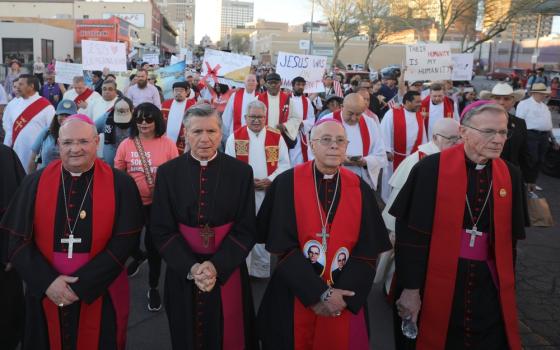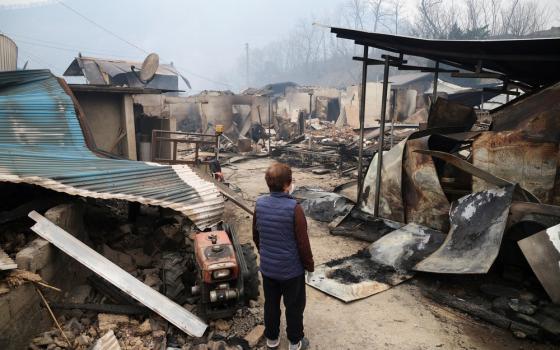Anyone in or around religious life in the United States these days knows two things: New members tend to come from a wide variety of ethnic backgrounds, especially Hispanics and Asian-Americans; and they tend to be more traditional in both theological outlook and spiritual style than older religious.
Thus in broad strokes, the results of a study released on Tuesday by the Center for Applied Research in the Apostolate at Georgetown University, carried out on behalf of the National Religious Vocations Conference, didn’t offer any real thunderbolts. Titled “Study of Recent Vocations to Religious Life,” the research surveyed 4,000 new members of religious communities, and basically confirmed the anecdotal impressions noted above.
The study contains plenty of nuggets about “best practices” in fostering and sustaining vocations that will be of specialized interest to vocation directors and anyone involved in formation. At the big-picture level, however, the most striking findings focus on what the next generation of religious women and men will be like.
In terms of ethnicity, CARA found that 21 percent of new members are Hispanic, 14 percent Asians or Pacific Islanders, and six percent Africans or African-Americans, meaning that about 58 percent are white. Since 94 percent of older members are white, religious life is obviously becoming more ethnically diverse -- which means no more than that it’s coming into alignment with the demographic breakdown of the broader Catholic community. (According to a recent Pew Forum study of religion in America, by 2030 only 48 percent of the Catholic population in America will be white, 41 percent will be Hispanic, and 7.5 percent will be Asian-American.)
With regard to theological and spiritual outlooks, the CARA study found clear differences between the “Millennial Generation,” meaning religious born after 1982, and the “Vatican II Generation,” meaning religious men and women born between 1943 and 1960.
Millennials are far more likely to say they entered religious life out of a desire for commitment to the church, and that they entered their specific community because of its reputation for fidelity to the church. They’re more likely to wear habits, more likely to say that devotions such as Eucharistic adoration and the Liturgy of the Hours are “very important,” less eager to do ministry in non-Catholic or non-confessional settings, and more positive in their attitudes about authority.
The corollary is that religious orders which foster a more traditional ethos tend to have better luck attracting younger members. One sign of which way the winds are blowing: Just one percent of women’s communities belonging to the Leadership Conference of Women Religious, known for having a more liberal outlook, currently have more than 10 new members in initial formation, whereas a robust 28 percent of communities belonging to the Conference of Major Superiors of Women, known for being more conservative, have 10 or more members in the early stages of membership.
To put all this into a sound-bite, the next generation of religious will be more ethnically diverse and more traditional.
* * *
That’s the data from the CARA study, which is straight-forward and essentially unassailable. The more subjective question, of course, is how these findings ought to be interpreted.
There’s what one might call the “ideological” interpretation in some conservative quarters, which amounts to a chest-thumping “we’re winning and you’re losing” response. (A brief and sarcastic statement released on Tuesday by the Catholic League, excoriating unnamed liberal “diversity dons” presumably flummoxed by the results, illustrates the psychology.) Some liberals will undoubtedly see the study in the same way, although they’re less likely to issue press releases or write blogs about it.
This ideological reading would see these results as a referendum on the progressive reform agenda of the Vatican II generation, concluding that young religious are voting with their feet against it.
A “generational” interpretation, on the other hand, would see these results in terms of differences in historical milieu. The Vatican II generation grew up within a strong Catholic culture and to some extent reacted against it, seeing it as overly stifling and controlling. The defining cultural crucible for millennials, however, has been a rootless secular world. They’re eager to establish a strong sense of Catholic identity, not to reform or redefine it. In essence, they’re reacting against the world, not the church.
Seen in that light, the commitment to orthodoxy and to traditional modes of life one sees among young religious today is less about the ideological contest of left versus right, and more about differences in generational experience.
Here’s yet a third explanation, this one arising out of the sociology of religion: the competitive edge of “high-tension” groups.
Both in the United States and around the world, those religious movements which have grown most dramatically over the last half-century are those with the clearest boundaries between themselves and the prevailing culture. In their 1987 book A Theory of Religion, Rodney Stark and William Bainbridge called this “high-tension religion.” Low-tension groups, according to Stark and Bainbridge, are usually dissolved into the “cauldron of secularism.”
This might seem a counter-intuitive result, because in the short run stricter groups may alienate some members. But over time, this attrition works to resolve what sociologists and economists call the “free rider” problem. High-tension groups screen out members with low levels of commitment, enhancing the participation levels of those who remain. This, in turn, drives more effective recruiting and retention.
Economist Laurence Iannaccone made this argument back in 1994, in an influential essay titled “Why Strict Churches Are Strong.” According to Iannaccone, strict churches (or, by extension, strict religious orders) attract members because, in the mercenary language of economics, they offer a better product. Here’s how Icannaccone described that product: “A church full of passionate members; a community of people deeply involved in one another’s lives and more willing than most to come to one another’s aid; a peer group of knowledgeable souls who speak the same language (or languages), are moved by the same texts, and cherish the same dreams.”
Significantly, “high-tension” and “conservative” are not coterminous. It’s entirely possible to foster a high-tension ethic within a church, or a religious order, that’s not premised on ideological conservatism. Within Catholicism, new movements such as Sant’Egidio or L’Arche illustrate the point; they have many of the characteristics of “high-tension” groups without falling on the ideological right. It’s simply a fact of life that in post-Vatican II Catholicism, many progressive groups and religious orders also adopted a more “low-tension” way of relating to the outside world.
Of course, Iannaccone acknowledged a point of diminishing returns. Too much strictness becomes self-defeating, making it virtually impossible for anyone other than a zealot to hang on. Still, his point was that both economic theory and empirical research suggest that “high-tension” groups enjoy a structural advantage in a competitive religious marketplace.
* * *
The point I’m trying to make is this: There are plenty of ways to understand this data beyond a victory for one side or the other in the church’s internal culture wars. These results deserve to be studied carefully and dispassionately, without leaping to conclusions about which political or theological agenda, if any, they support.
The one seemingly inescapable conclusion is that the Catholic future, inside religious life and out, promises accelerating diversity in terms of ethnicity, life experience, and worldviews. How the church copes with that diversity looms as a defining challenge … and my bet is that the future belongs to those forces that best resist the lure of a “zero-sum” logic always wanting to think in terms of winners and losers.
The full text of the study can be found on the Web site of the National Religious Vocations Conference at: www.nrvc.net.
* * *
Related stories:
New vocations in U.S. ethnically, culturally diverse
John L. Allen Jr. is NCR senior correspondent. His e-mail address is jallen@ncronline.org.




